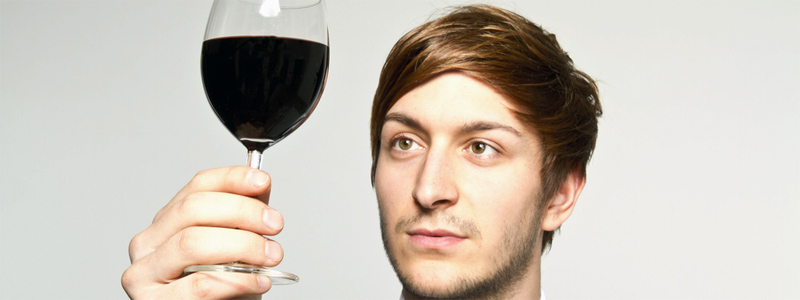The first step in tasting a wine happens before you actually taste the wine. When the wine is first poured into your glass — before swirling it, smelling it, or sipping it — just look at it. The reason you look at the wine is to get a sense of its color, as a wine’s color can tell you a lot about the wine you’ll be drinking. When doing this, many people like to hold their glass of wine against a white background, as that helps you see the hue of the color more easily.
A wine’s color can tell you a lot about the wine you’ll be drinking.
So why do we care about color? The first thing to remember is that the color of a wine comes from contact with the grape skins after the grapes have been juiced. The longer the wine comes in contact with those skins, the more those skins will impart their color on the wine. Quick aside — if you skinned the grapes and juiced them, never letting them come in contact with their skins, the resulting wine would have no color at all! Because the grape skins have a lot of their own characteristics, just like the zest of an orange has purer orange flavor, or an apple skin contains more fiber than the meat, the longer the skin of a grape is in contact with the wine, the more of its own characteristics it imparts. On top of this, oak can also help make colors lighter or darker, so understanding color, especially for white wines, can help people who don’t like oaky white wines avoid them.
Let’s Start With White Wine:
First look at the shade of yellow. Is the yellow very light and bright, approaching clear, or is the yellow deep and full, almost approaching the color of straw? Light and bright white wines that you can see through have had minimal contact with the grape skins and are usually crisp and refreshing, like lemonade on a hot summer day. Typically, these wines have not been aged in an oak barrel.
If the wine is darker and deeper in yellow, then this is usually a good sign that the wine was aged in an oak barrel. It will have a smoother taste and will be much fuller and richer.
Now Let’s Look At Red Wine:
The same steps hold true when examining a red as with a white. Start by looking at the shade of red wine in your glass If the wine is light red, even approaching pink, it should taste light and bright. It may even be a little tart or “fresh” tasting and that is because the lighter the red of a wine, the less likely that it was ever aged in oak, and oak is what helps round and mellow a wine.
As the hue of the red wine gets darker and darker, approaching the colors of maroon and purple, the red will become much bolder and richer. These types of red wine are the ones you think of when you think red wine and steak dinner, and the darker and deeper the color, the longer they’ve spent aging in an oak barrel.
Now that you’re an expert in examining and understanding the color of the wine you’re going to drink, it’s time to swirl it around your glass.
